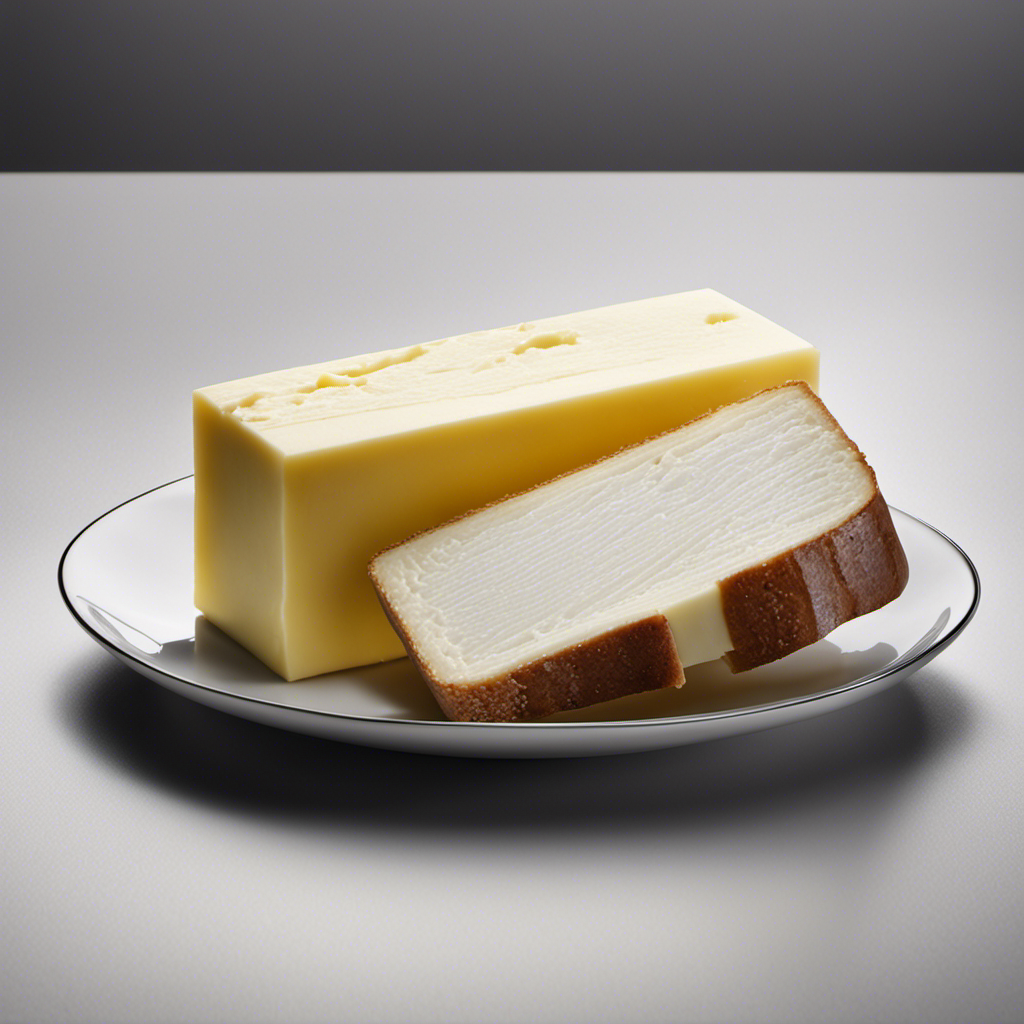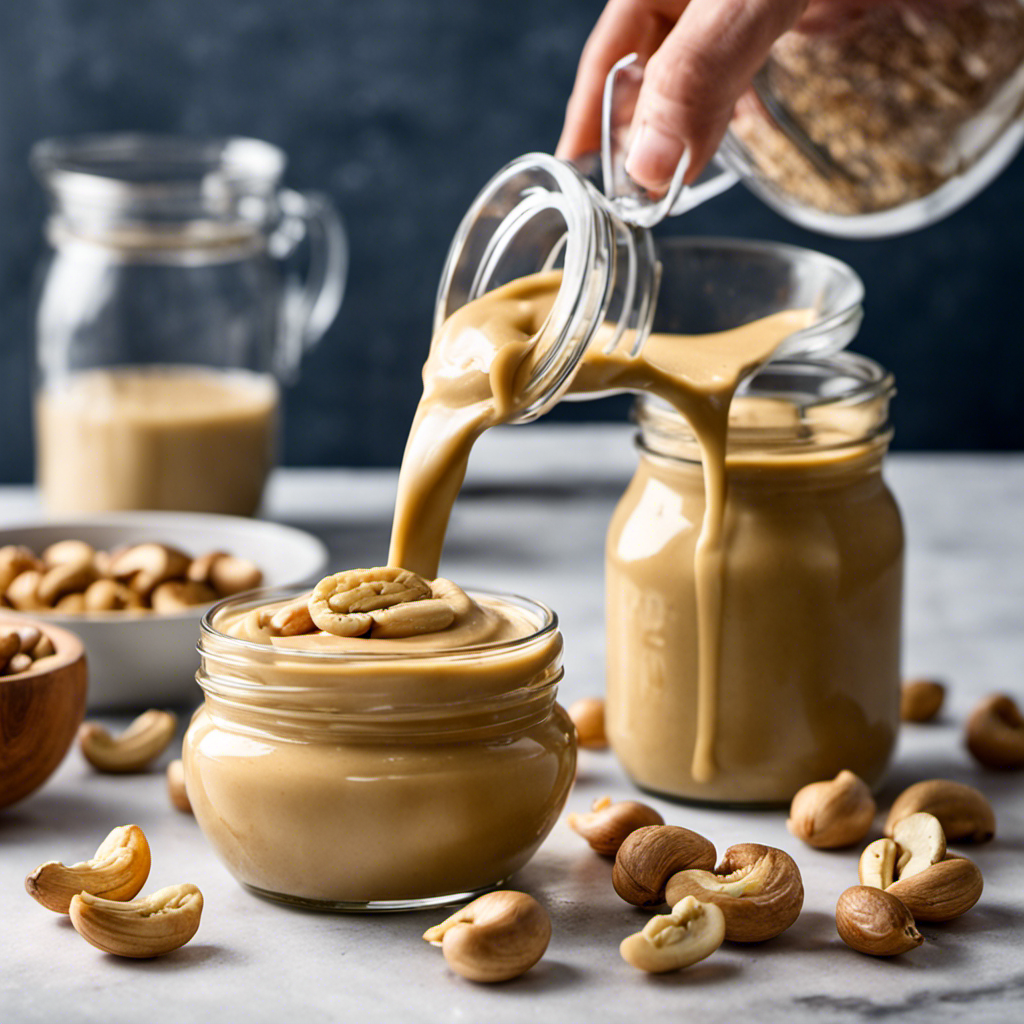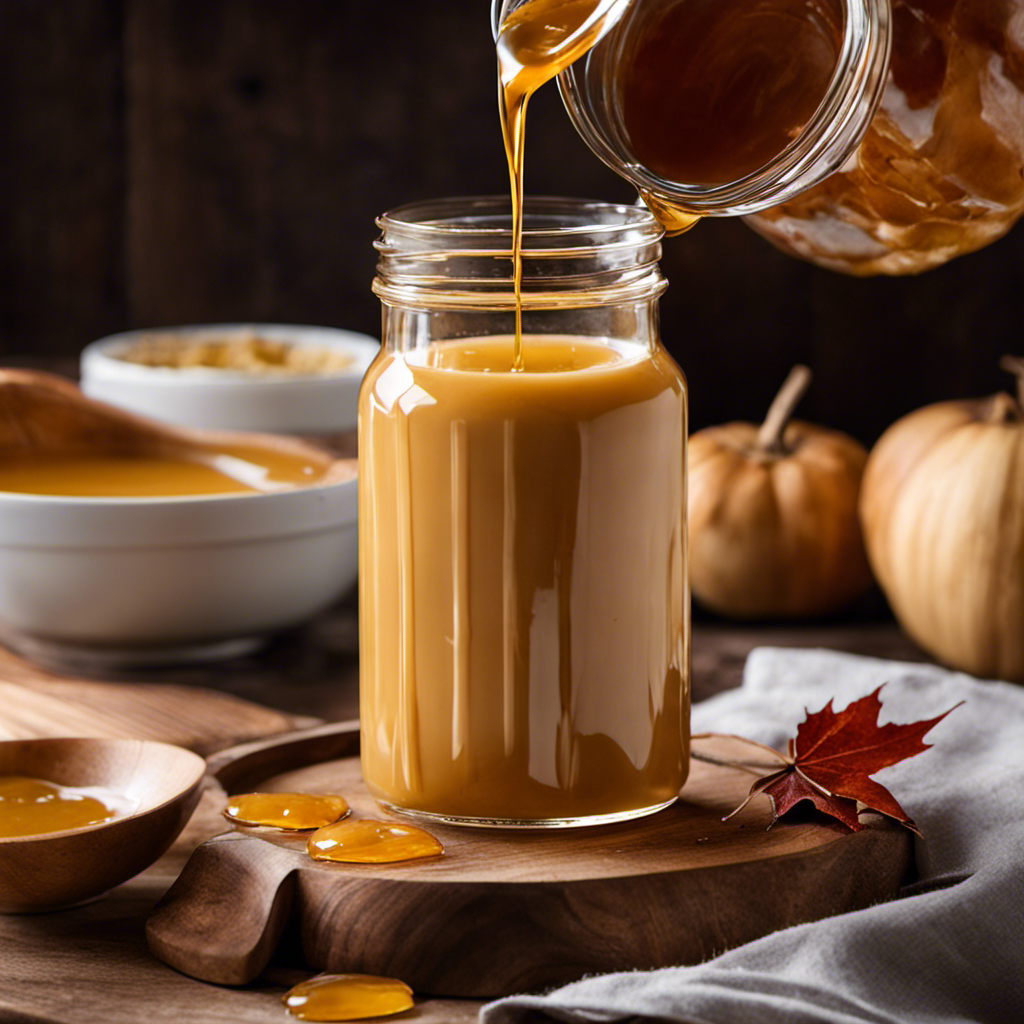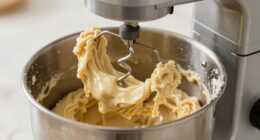I recall the irritation of attempting to spread cold butter on my toast in the morning, seeing it tear the soft bread. However, I found a straightforward solution–how to soften cold butter to room temperature.
In this article, I’ll share the science behind softening butter and provide quick and effective methods to achieve the perfect spreadable consistency. Whether you prefer to use the microwave, stovetop, or oven, I’ve got you covered.
Get ready to enjoy buttery bliss on every bite!
Key Takeaways
- Softened butter is easier to spread on toast and baked goods and blends more easily with other ingredients.
- Softened butter results in a smooth and creamy texture and allows for better creaming with sugars.
- Softened butter incorporates air during mixing for lighter and fluffier baked goods.
- Quick methods to soften cold butter include the microwave method, grating method, and alternative methods such as rolling and creaming.
Why Room Temperature Butter Is Better
Why room temperature butter is better is because it is easier to spread on toast and other baked goods. When butter is cold, it is hard and difficult to spread evenly. However, when butter is at room temperature, it becomes soft and spreadable, allowing it to melt into the warm bread or pastry effortlessly.
Another benefit of using room temperature butter is that it blends more easily with other ingredients, such as sugar or flour, resulting in a smooth and creamy texture.
To store room temperature butter, simply leave it out on the counter in a covered butter dish or a butter crock. Make sure to keep it away from direct sunlight or heat sources to prevent it from melting or becoming rancid.
The Science Behind Softening Butter
Understanding the science behind softening butter can help ensure successful baking results. When butter is cold, its melting point is higher, making it difficult to incorporate into recipes. Here’s why:
-
Butter melting point: Butter is made up of various fatty acids, and each fatty acid has a different melting point. When butter is cold, these fatty acids are solid and tightly packed, resulting in a higher melting point.
-
Enzyme activity: Softening butter involves allowing enzyme activity to take place. When butter is left at room temperature, enzymes naturally present in the butter start breaking down its structure. This enzymatic activity lowers the melting point of the butter, making it easier to work with in baking recipes.
-
Uniform texture: Softened butter ensures a more uniform texture in baked goods. It allows for better creaming with sugars and easier incorporation of air during mixing, resulting in lighter and fluffier baked goods.
Understanding these factors can help you achieve the perfect texture and consistency in your baked treats by properly softening your butter.
Quick Methods to Soften Cold Butter
To quickly soften your butter, you can use a microwave or grate it using a cheese grater. These alternative methods are handy when you need room temperature butter for baking or spreading. The microwave method is simple but requires caution to avoid melting the butter. Place the cold butter on a microwave-safe plate and heat it in short bursts of 5 to 10 seconds until softened. The grating method involves using a cheese grater to shred the cold butter into fine pieces. Spread the grated butter onto a plate and let it sit at room temperature for a few minutes until softened. Both methods offer quick solutions for softening cold butter without waiting for it to naturally reach room temperature.
| Microwave Method | Grating Method |
|---|---|
| Heat in short bursts | Shred with a cheese grater |
| Caution to avoid melting | Spread on a plate |
| Check frequently | Let sit at room temperature |
| Quick and convenient | Fast and effective |
How to Soften Butter in the Microwave
Using the microwave is a quick and convenient way to soften butter. However, if you’re looking for microwave alternatives or prefer to soften butter without heat, there are a few methods you can try.
-
Grating: Using a cheese grater, grate the cold butter into small, manageable pieces. This will increase the surface area and allow it to soften faster at room temperature.
-
Rolling: Place the cold butter between two sheets of parchment paper and use a rolling pin to gently flatten it. This will help soften the butter without applying direct heat.
-
Creaming: Cut the cold butter into small cubes and place them in a bowl. Use a hand mixer or stand mixer to beat the butter until it becomes soft and creamy. This method incorporates air into the butter, making it easier to spread.
Softening Butter Using the Stovetop Method
When it comes to softening butter, there are two popular methods: the stovetop method and the microwave method. Each method has its pros and cons, and it’s important to consider factors such as time-saving tips and keeping butter fresh.
In this discussion, I will compare the stovetop and microwave methods, share some time-saving tips, and provide suggestions for keeping butter fresh.
Stovetop Vs. Microwave
If you’re short on time, the microwave is a quicker option for softening cold butter compared to using the stovetop. Here are some reasons why the microwave method can be advantageous:
- Speed: Microwaving butter takes only seconds, while using the stovetop can take several minutes.
- Control: With the microwave, you have more control over the softening process since you can adjust the time in small increments.
- Convenience: Using the microwave is more convenient, especially if you’re in a hurry or don’t want to dirty additional utensils.
However, there are a few disadvantages to using the microwave:
- Uneven Softening: Microwaving butter can lead to uneven softening, with some parts melting while others remain cold.
- Potential for Overheating: If you’re not careful, the butter can easily melt and become too runny.
- Loss of Flavor: Microwaving butter can potentially diminish its flavor due to the quick heating process.
Despite these drawbacks, the microwave is a convenient option when time is of the essence.
Time-Saving Tips
Now that we’ve discussed the different methods of heating cold butter, let’s explore some time-saving techniques for getting butter to room temperature quickly.
One alternative method is to grate the cold butter using a cheese grater. This increases the surface area of the butter, allowing it to soften faster.
Another time-saving technique is to place the butter between two sheets of parchment paper and roll it out using a rolling pin. This flattens the butter and exposes more of it to room temperature, helping it soften in a shorter amount of time.
Additionally, you can try cutting the butter into smaller pieces before leaving it out at room temperature. This will decrease the overall time it takes for the butter to soften.
These alternative methods are great for situations when you need room-temperature butter in a pinch and don’t have time to wait.
Keeping Butter Fresh
To extend the shelf life of butter, it’s best to store it in an airtight container in the refrigerator. This helps in keeping butter fresh and preserving its quality for a longer period.
Here are some tips to ensure your butter stays fresh and flavorful:
-
Keep it sealed: Place the butter in an airtight container or wrap it tightly in foil or plastic wrap to prevent air and moisture from getting in.
-
Store in the fridge: The cool temperature of the refrigerator helps slow down the oxidation process, keeping butter fresh for longer.
-
Use it within the recommended time: Butter typically has a shelf life of about 1-2 weeks in the refrigerator. Be sure to check the expiration date and use it before it goes bad.
Softening Butter in the Oven
When it comes to softening butter quickly and effectively, using the oven is a great alternative to the countertop method.
Preheating the oven to a low temperature, around 200°F (93°C), and placing the cold butter on a baking sheet allows it to gradually soften without melting.
This method is especially useful when you’re short on time and need softened butter for baking or cooking.
Quick and Effective Method
If you’re in a hurry and need room temperature butter fast, you can try using warm water to quickly soften it. This is one of the quickest and most efficient techniques I’ve found for softening butter on the spot.
Here are some quick tips to help you use this method effectively:
- Fill a glass or bowl with warm water.
- Cut your cold butter into smaller pieces to speed up the process.
- Place the butter in a heatproof bag or wrap it tightly in plastic wrap to prevent water from getting inside.
By submerging the butter in warm water, it will gradually soften without melting completely. Remember to check the butter every few minutes and knead it gently to ensure even softening. Once it reaches room temperature, it’s ready to use in your recipe.
This technique is a real time-saver when you need softened butter in a pinch.
Alternative to Countertop Method
You can also try the microwave method, which is a convenient alternative for quickly softening your butter.
To do this, place the cold butter in a microwave-safe bowl and heat it on low power for 10-second intervals. Make sure to check the butter after each interval to avoid melting it. The microwave method works by gently warming the butter, allowing it to reach room temperature faster. However, it is important to be cautious when using this method as butter can melt quickly if heated for too long.
Once the butter is soft to the touch, it is ready to be used in your recipe.
Now, let’s move on to some additional tips and tricks for softening butter even faster.
Tips and Tricks for Softening Butter Faster
One easy way to soften butter faster is to place it in the microwave for a few seconds. This method is quick and convenient, especially when you need softened butter in a hurry. However, it’s important to be cautious and not overheat the butter, as it can quickly melt and become unusable.
Here are some tips and tricks to help you achieve the perfect butter temperature and consistency:
-
Use the microwave in short bursts: Start by microwaving the butter for 5-10 seconds, then check its consistency. If it’s still too firm, microwave it for another 5 seconds and check again. Repeat this process until the butter is soft but not melted.
-
Cut the butter into smaller pieces: By cutting the butter into small cubes or slices, you can accelerate the softening process. Smaller pieces of butter will heat more evenly and soften faster.
-
Use a microwave-safe plate or bowl: Place the butter on a microwave-safe plate or in a microwave-safe bowl to avoid any potential mess or damage to your microwave.
Frequently Asked Questions
Can I Use Frozen Butter Instead of Cold Butter to Speed up the Softening Process?
Yes, you can use frozen butter instead of cold butter to speed up the softening process. It’s a great alternative for baking or any recipe that calls for room temperature butter.
How Long Does It Take for Butter to Reach Room Temperature Naturally?
I’m not sure how long it takes for butter to reach room temperature naturally, but I can tell you how to soften butter quickly. The ideal temperature for room temperature butter is around 65 to 70 degrees Fahrenheit.
What Is the Best Way to Store Softened Butter to Maintain Its Texture and Prevent It From Becoming Too Soft?
The best ways to soften butter without using heat are leaving it at room temperature, cutting it into small pieces, or using a grater. To store softened butter, wrap it tightly in wax paper or plastic wrap and refrigerate.
Can I Use a Hairdryer or Heat Gun to Soften Cold Butter Quickly?
Using a hairdryer or heat gun to quickly soften cold butter is not recommended. Instead, try alternative methods like cutting the butter into smaller pieces or placing it in a warm water bath.
Is It Safe to Consume Butter That Has Been Softened Using Unconventional Methods Such as Placing It Near a Warm Oven or Heating It in a Microwave for an Extended Period of Time?
Using unconventional methods to soften butter, like placing it near a warm oven or heating it in a microwave for an extended period of time, may affect its taste. Understanding the science behind temperature and butter’s texture is important.
Conclusion
In conclusion, softening cold butter doesn’t have to be a daunting task. By using quick methods like the microwave, stovetop, or oven, you can easily achieve room temperature butter for all your baking needs.
Remember, room temperature butter is like a warm embrace, smoothly blending into your recipes and creating a perfect harmony of flavors.
So don’t let cold butter slow you down, try these tips and tricks to enjoy the magic of room temperature butter in your culinary adventures.








